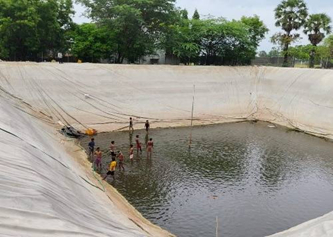Last Updated: December 24th, 2024

Aligned with the Chancellor’s vision and Amrita’s Sustainable Campus Policy, the university has implemented water-conscious building standards across all its campuses. Amrita has designed its buildings with water-positive principles at the forefront, ensuring that the water consumption on campus is replenished in ways that support sustainability and environmental restoration.
The use of pressure controllers in high-rise buildings, installed every three floors, reduces water pressure and minimizes water wastage. Additionally, Amrita has implemented dual flush systems in toilets and urinals, significantly cutting down on water usage. These efforts reduce overall water consumption in the built environment. To further optimize water use, the campus is equipped with remote water monitoring systems, allowing real-time tracking and management of water resources. Furthermore, 30% of the water used for flushing is sourced from treated water, which reduces reliance on potable water and emphasizes the university’s commitment to sustainable water management.
Rainwater harvesting is a key feature in Amrita’s water-conscious strategy. With 65,000 square meters of rooftop area dedicated to collecting rainwater, the university captures approximately 55,000 cubic meters of rainwater annually. This is stored in 16 tanks with a combined capacity of 24,000 cubic meters, directly supporting the university’s goal to conserve and utilize water responsibly. Amrita’s rainwater harvesting infrastructure ensures the efficient use and management of water, directly contributing to both water conservation and groundwater recharge. Additionally, 16 check dams and three remotely managed borewells are utilized to recharge the groundwater table, enhancing local water security.
The university has integrated a variety of water-saving technologies across the campus. Plate-washing machines, power cleaning techniques for building floors, and sprinkler and drip irrigation systems for gardens all contribute to reducing water waste. Aerated taps in high-traffic areas like mess halls ensure that water consumption is minimized without sacrificing functionality. By 2026-27, Amrita plans to expand sensor-based taps throughout the campus, further improving water efficiency and aligning with global standards for water conservation.
Amrita Vishwa Vidyapeetham is committed to ensure that water is used most judiciously and reused to the maximum extent possible. Amrita Institute of Medical Sciences campus under Amrita Vishwa Vidyapeetham is being constructed to be GRIHA and LEED certified: a green building, with no carbon footprint, zero wastewater discharge, and to be powered eventually by more than 45% solar power. Construction materials used in the project are also environmentally friendly. More than 70% of the campus acreage is planned as a green area filled with local varieties of trees, plants and shrubs and water bodies.
Water is supplied 24 hours a day without interruption for drinking and other purposes. This prevents improper storage by residents in anticipation of water shortage, as mandated by IS 2065: 1983 (Second Revision) – Code of practice for water supply in buildings (Second Revision). This practice also aligns with International Plumbing Code (2018) – Section 601.
The university adopts self-curing construction techniques to reduce evaporation and water usage during building construction phases, following IS: 10262-2009 standards.
Rainwater harvesting facilities are installed for every building at university and hostels, complying with IS 15797 (2008) Roof top rainwater harvesting – Guidelines. This implementation also meets International Plumbing Code (2018) – Section 606 requirements.
The university ensures water pressure is kept optimal in pipelines in order to reduce water loss using pressure reducing valves. This practice follows IS 9739 (1981): pressure reducing valves for domestic water supply systems, and International Plumbing Code (2018) – Section 604.
An active plumbing team conducts routine maintenance and corrects leakages throughout the campus. The university uses aerators and pressure reducing nozzles at taps in order to reduce water loss. Proximity sensor based taps are installed at wash areas to prevent unnecessary water loss. These measures comply with SP 35 (1987): Handbook on Water Supply and Drainage (with Special Emphasis on Plumbing) and International Plumbing Code (2018) – Section 312.
ASTM and C-PVC pipes are used throughout the campus for reduced leakages, conforming to IS 15778 (2007): Chlorinated polyvinyl chloride (CPVC) pipes for potable hot and cold water distribution supplies, and International Plumbing Code (2018) – Section 402.
Modern dual syphon flush tanks are installed at toilets for judicious water usage. The university maintains separate urinals and flush toilets for boys, in order to save water on unnecessary flushing. These installations comply with IS 774 (2004): Flushing Cistern for Water Closets and Urinals (Other Than Plastic Cisterns) and International Plumbing Code (2018) – Section 402.
Rainwater and recycled water are utilized for construction purposes, following EPA/625/R-04/108 Guidelines for Water Reuse.
The university implements comprehensive water conservation practices across all facilities. Water is supplied continuously throughout the day to prevent hoarding and improper storage by residents. Self-curing construction techniques reduce water consumption during building phases. Rainwater harvesting infrastructure supports every building and hostel facility. The active plumbing team ensures prompt identification and repair of leakages across the campus. Pressure control mechanisms maintain optimal water flow throughout the pipeline network. Modern fixtures including dual flush systems and sensor-based taps minimize water wastage at points of use. The selection of high-quality ASTM and C-PVC piping systems reduces losses from leakage. Separate sanitary facilities for different purposes ensure that water is used only when necessary.


Through these comprehensive water-conscious building standards, Amrita Vishwa Vidyapeetham demonstrates its commitment to environmental sustainability and responsible water stewardship. The integration of traditional rainwater harvesting with modern monitoring and control systems, combined with strict adherence to both Indian and international plumbing standards, positions the university as a leader in sustainable campus development. The ongoing expansion of sensor-based technologies and the pursuit of green building certifications reflect the institution’s dedication to continuous improvement in water conservation efforts.
Campus sustainability Policy >>
Office Order for Sustainable Campus Policy >>
General Guidelines for Building Construction >>